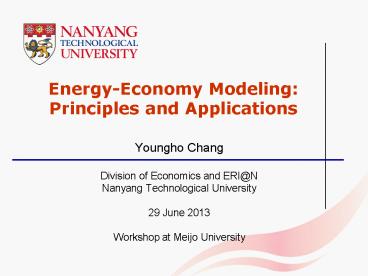Energy-Economy Modeling: Principles and Applications - PowerPoint PPT Presentation
Title:
Energy-Economy Modeling: Principles and Applications
Description:
Title: PowerPoint Presentation Last modified by: GREENLEE Created Date: 1/1/1601 12:00:00 AM Document presentation format: (4:3) – PowerPoint PPT presentation
Number of Views:76
Avg rating:3.0/5.0
Title: Energy-Economy Modeling: Principles and Applications
1
Energy-Economy ModelingPrinciples and
Applications
- Youngho Chang
- Division of Economics and ERI_at_N
- Nanyang Technological University
- 29 June 2013
- Workshop at Meijo University
2
Agenda
- Models in energy sector
- Analysis of energy technologies
- Economic impacts of energy choice
- Conclusions
3
Energy
- Socio economic development and energy
- Rise in oil price
- is a reminder of resource crunch that must be
continuously tackled - Energy supply must be done more efficiently and
with more environmentally friendly and efficient
technology - This also means that energy demand must also be
managed
4
Group of Energy Resources
- Traditional (often called biomass resources )
- fuelwood, crop residues and livestock residues
- due to large volume and traditional use, they
fall under traditional category - They are considered non-monetized although they
are sold in some of the markets - Commercial
- fossil fuels and electricity
- both can be used to obtain an energy service
- Non-conventional or renewable
- mainly renewable energy sources such as solar
wind and biogas.
5
What Is a Model?
- We must understand the best way to supply energy
for a reasonable demand - Therefore, two end points are supply and demand
- Various types of models available
- Suitability of model depends on the goal of
modeling, data and software availability and
competence of the modeler. - Simplification of complex amalgamation of systems
and variables. - Back of the envelope calculations.
- Complex computer calculations
6
Energy Modeling
- Model types
- Supply based models
- Demand based models
- Hybrid models
- Simulation models can fall under this category as
well (ENPEP/BALANCE, Energy 20/20) - In the analysis of climate/energy related
policies, two general types of models have been
used - Top-down (e.g., general equilibrium or
macro-economic frameworks) and - Bottom-Up (e.g., energy system models).
7
Supply based models
- Accounting model
- Mainly based on database
- If the status quo pattern stays, what would be
the energy requirementmost popularly used model - Long Range Energy Alternatives Planning Model
(LEAP) - Optimization models
- Linear to non-linear optimization models
- Developed a multi-period linear optimization
model with stochastic and non-stochastic
parameters - Combining generation and transmission
- Market Allocation Model (MARKAL)
- Both are mainly used on a macro level- country
level energy analysis
8
Hybrid model
- Econometric model
- various socio-economic parameters
- population, stretch of road (KM extension),
number of vehicles, number of houses built,
economic performance of the country, and family
income. - Based on time series data of actual consumption.
- The best model fits the actual consumption.
- The projection is based on the status of
parameters assumed for the future. - Econometric models are not the end but the
beginning of energy modeling exercise
9
Econometric model
- Good for medium range planning (5-10 years)
- But economy is changing very fast
- As the structure of economy can change, the
pattern of energy consumption might also change - Many companies manufacturing heavy equipment have
shifted to China. - This changes the requirement for reliable motor
power - This will also shift the energy requirement to
other sector such as servicing - Singapore, Hong Kong, Britains economy has
shifted from materialized economy (heavy
manufacturing) to non materialized economy
10
Changing economic structure
http//www.sml.hw.ac.uk/logistics/Decoupling_of_Ro
ad-tonne-km_and_GDP.pdf
11
Reference Energy System
12
Model Building Blocks - Data Categories
Demand for Energy Service
End-Use Technologies
Conversion Technologies
Primary Energy Supply
(Final Energy)
(Useful Energy)
Industry, e.g. -Process steam -Motive
power Services, e.g. -Cooling -Lighting Househol
ds, e.g. -Space heat -Refrigeration Agriculture,
e.g. -Water supply Transport, e.g. -Person-km
Industry, e.g. -Steam boilers -Machinery Services
, e.g. -Air conditioners -Light
bulbs Households, e.g. -Space heaters -Refrigerat
ors Agriculture, e.g. -Irrigation
pumps Transport, e.g. -Gasoline Car -Fuel Cell
Bus
Fuel processing Plants e.g. -Oil
refineries -Hydrogen prod. -Ethanol prod. Power
plants e.g. -Conventional Fossil Fueled
-Solar -Wind -Nuclear -CCGT -Fuel
Cells -Combined Heat and Power
Renewables e.g. -Biomass -Hydro Mining
e.g. -Crude oil -Natural gas -Coal Imports
e.g. -crude oil -oil products Exports
e.g. -oil products -coal Stock changes
13
The MARKAL Model
- Utilizes a bottom-up approach to represent and
characterize technology specific portfolios of
the entire energy - materials flow system
synergies, offset and feedback effects - Provides a dynamic integrated framework to assess
market competition, technology diffusion and
emission/waste accounting - Facilitates Program Managers in selecting
technology mix over the entire energy - materials
system based on life cycle accounting and least
cost - Solves as a mathematical programming problem
14
(No Transcript)
15
(No Transcript)
16
(No Transcript)
17
(No Transcript)
18
(No Transcript)
19
(No Transcript)
20
(No Transcript)
21
(No Transcript)
22
MARKAL-MACRO Overview
23
How MARKAL-MACRO Reacts to Environmental
Constraints?
- Intra-technology substitution (i.e., within a
particular technology category) occurs to meet
the energy demand more efficiently. - Inter-technology substitution (i.e., among
competing technologies servicing a particular
energy demand) occurs. - Less carbon-intensive energy resources/ fuels are
used to meet energy demands across sectors. - It reduces energy demand, which reduces economic
output consequently.
24
Example































